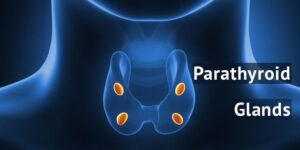
- The parathyroid glands are four pea-sized glands, one is usually located behind each of the four corners of the thyroid gland in the neck (Para = beside; Para-thyroid = beside the thyroid)
- Though neighbors, the thyroid and parathyroid glands are separateglands, and they work on different functions.
- While the thyroid produce a hormone that accelerate the chemical reactions in the body, The parathyroid glands secrete the parathyroid hormone (PTH), which ensures that calcium level in the blood does not drop, and that is by:
What do they do?
- Regulating the release of calcium from the BONE
- Making vitamin D more active, and that increases the absorption of calcium from the GUT
- Decreasing the leak of calcium through the KIDNEY into urine
- Calcium is so important for:
- Building bone and teeth
- Nerve and brain function (transmission of signals)
- Heart beating
- Muscle contraction
What is Hyperparathyroidism?
- Hyperparathyroidism means having too much PTH in the blood.
- This can be appropriate if it is in response to low calcium in the blood; we call that secondary hyperparathyroidism (i.e. secondary to, or caused by low calcium) as it tries to get calcium back up to normal level.
- On the other hand, PTH may be high on its own, without need, we call that PRIMARY HYPERPARATHYROIDISM. This results in:
- High calcium in the blood (hypercalcemia);
- Thinning of bones (osteoporosis) with potential for fractures, and
- Dumping too much calcium in urine, leading sometimes to kidney stones or kidney failure.
- A small benign tumor (adenoma) in one of the parathyroid glands. This is the most common scenario.
- However, it could also be caused by simple enlargement and over-activity of several parathyroid glands (hyperplasia).
- Very rarely, hyperparathyroidism is caused by cancer of a parathyroid gland.
What causes Primary Hyperparathyroidism?
- A small benign tumor (adenoma) in one of the parathyroid glands. This is the most common scenario.
- However, it could also be caused by simple enlargement and over-activity of several parathyroid glands (hyperplasia).
- Very rarely, hyperparathyroidism is caused by cancer of a parathyroid gland.
What are the symptoms?
- No symptoms (discovered accidentally on lab test)
- Classic Symptoms
- BONES: fractures
- STONES: of the kidney, with increased urination and thirst
- MOANS: depression, confusion or impaired thinking and memory
- GROANS: of the abdomen, loss of appetite, nausea, vomiting, constipation, peptic ulcers and pancreatitis (inflammation of the pancreas)
- Non-specific Symptoms
- weakness and fatigue
- body aches and pains
- high blood pressure
- Blood tests: finding high PTH in the face of a calcium level that is high or on the high side of the normal range.
- Parathyroid scan (using a nuclear isotope, Sestamibi): you get an injection, then they take pictures of your neck (by counting how much radiation is radiating from the parathyroid glands).
- Bone density (DXA scan): to see how thins your bones are.
- Other tests as necessary, such as kidney ultrasound, or collecting urine for 24 hours in a jug to measure urine calcium (the lab gives the jug to you, and when you are done with it, you return it to the lab for them to measure the calcium in it.)
- Surgery
How is it diagnosed?
- Blood tests: finding high PTH in the face of a calcium level that is high or on the high side of the normal range.
- Parathyroid scan (using a nuclear isotope, Sestamibi): you get an injection, then they take pictures of your neck (by counting how much radiation is radiating from the parathyroid glands).
- Bone density (DXA scan): to see how thins your bones are.
- Other tests as necessary, such as kidney ultrasound, or collecting urine for 24 hours in a jug to measure urine calcium (the lab gives the jug to you, and when you are done with it, you return it to the lab for them to measure the calcium in it.)
How is it treated?
- The only treatment that cures it
- Especially indicated if there is a significant damage to one of the body organs, or significant risk of such damage, such as:
- Significant symptoms (mentioned above)
- Significantly high calcium
- Bone thinning or fractures
- Kidney damage or stones
- Relatively young age (higher chance of future damage)
- The surgeon makes a small cut in the lower part of the neck, looks for the tumor, and removes it.
- Apart from the regular risks of any surgery (e.g. bleeding, infection, anesthesia problems), which are uncommon, there are specific potential complications to parathyroid surgery:
- Low calcium (1-5%), this may require treatment with calcium and/or vitamin D.
- Damage to the nerve that works the voice box (resulting in hoarseness of voice, which could be transient, but rarely can be permanent)
- Conservative Management:
- Indicated when there is no compelling indication for surgery (mentioned above).
- It consists of:
- Ensure hydration, especially when having vomiting or diarrhea (drink lots of fluids)
- Avoid immobility (do some physical activity).
- Regular visits to the doctor, along with lab work every 6 months.
- Bone density measurement every 1-2 years.
- If the disease shows no signs of worsening over time, the interval between exams may be lengthened.
A link is not working? Please, Contact us. Thank you.
